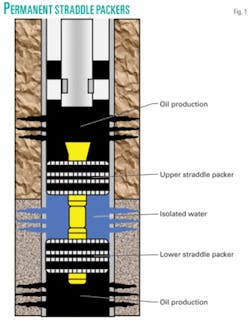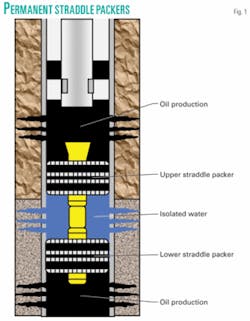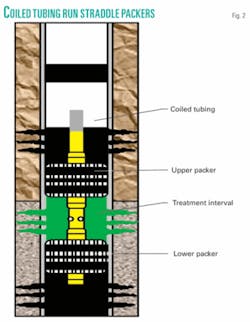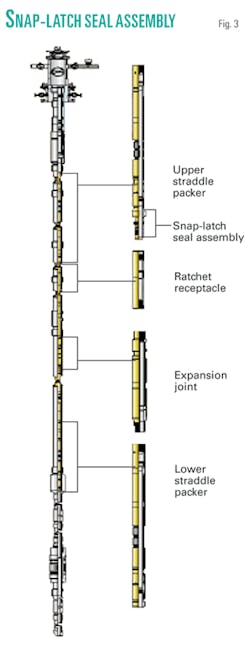In well completions, straddle packers offer a way to shut off zones from producing or injection intervals above or below the packers. In this article, two examples from completions in the North Sea and one off Brazil illustrate the use of straddle packers.
In its simplest form in an oil field application, a straddle assembly will have two packers connected to each other in a manner that isolates the section between these two packers from the zones above and below the assembly.
Packers differ from bridge plugs in that packers have an unrestricted ID that allows for fluid flow from top to bottom or vice versa. Bridge plugs, on the other hand, are tools that, when set in a well, have no through-bore communication and prevent fluid flow in either direction.
This article discusses two main types of straddle packer operations. In the first, a straddle assembly is in either a temporary or permanent application whereby the straddle shuts off the area between the two packers from either production flow or surface injection and subsequently allows for continued production from or injection into zones both above and below the set packers.
The second operation consists of temporary retrievable service-type straddle assemblies placed in position and left in communication with a service string such as threaded or coiled tubing (Fig. 1). These assemblies provide a means to perform pumped remedial operations such as zonal stimulation.
One primary requisite of a straddle packer is a minimal OD to ID ratio. A larger straddle packer ID provides less resistance to flow, creating less of a downhole choke. Also, a larger ID facilitates running well servicing tools below the packers for such operations as perforating, logging, or plugging back.
Nonservice straddles
The nonservice-type straddle assemblies are deployed in either through-tubing or in the full bore. Common applications for these straddles include:
- Isolate intermediate zones.
- Isolate upper zones.
- Insert sand-control screens.
- Insert flow-control equipment.
- Install velocity strings.
Through-tubing straddle assemblies on coiled tubing have the advantage of allowing deployment of downhole equipment in a live well. This reduces health, safety, and environmental requirements, allows for faster trip times, reduces operational footprint, eliminates kill weight fluids, keeps wells on production during intervention, and eliminates the need to remove completion equipment.
Baker Oil Tools inflatable straddle systems have a small run-in OD to facilitate running through the completion string and creating a seal in the larger casing ID below.
A variety of designs and sizes of through-tubing, inflatable straddle assemblies is available for both permanent and retrievable options. The assemblies can be as simple as two standard inflatable packers and interval spacing to as complex as running fit-for-purpose, exotic material devices more than 1,500 ft in length.
A through-tubing permanent straddle packer assembly includes inflatable packers designed to isolate permanently a wellbore section. The packers are set one at a time or both in the same trip. These assemblies are run on threaded tubing, coiled tubing, or electric wireline.
In-hole latching mechanisms allow the straddle assembly to be run in sections, thereby facilitating longer straddles in cases where a complete assembly length does not fit in the surface riser or lubricator.
The production or injection areas within the wellbore are not the only areas that may require straddle isolation for remediation. If the upper production tubulars develop holes or leaks, straddle assemblies can isolate areas, thereby eliminating well workovers that require pulling out downhole tubulars.
Service straddles
Service-type straddle assemblies also are deployed either through tubing or in the full bore. In treatment operations, these assemblies with inflatable packers on coiled tubing have the same advantages as previously listed for nonservice assemblies.
An inflatable straddle acidizing packer (ISAP) allows precise injection of acid or other chemical treatments into short, select wellbore sections. This feature replaces other less effective methods used previously for selectively placing treating fluids, such as bull-heading, ball sealers, or chemical diverters. The inflatable straddle assembly primarily is run on coiled-tubing workstrings; thus the tool operates within the safe tension, set down, and pressure limits of the coiled tubing.
Straddle assemblies that require only a slight tension and no set down weight for operation are ideal for applications in horizontal or highly deviated wellbores. The inflatable straddle assembly has a resettable design, thus a single trip in the well can treat multiple intervals.
The design of the inflatable elements also allows the packers to be set in perforations, screens, or open holes. This facilitates treatment of long, continuous intervals without the need for a blank casing packer seat in which to set the elements. Installation of threaded spacers can adjust the spacing between the top and bottom packer sections (Fig. 2).
Another service straddle assembly is an inflatable, multiset, straddle packer for zonal isolation service work in cased and openholes. The inflatable test and treat system (ITTS) can treat or test flow from selective intervals.
The ITTS design allows it to be run on threaded pipe, in vertical, deviated, and horizontal wellbores, so that short sections of the formation can be chemically treated precisely or flow tested. This straddle is a modular assembly that can be made up as it is being run in the hole.
The straddle assembly has a two-position operation: pick up for setting, and set down for injection and testing. The ITTS design allows for treatment and testing multiple zones in a single trip, saving the operator rig time during intervention operations.
Full-bore straddles
In a monobore (nonrestricted), the full-bore straddle assembly has the advantages of a more robust design, higher pressure capability, and pinpoint placement accuracy of treatment fluids.
One main technology development in recent years is a full-bore straddle tool with no packer cups for pressure isolation and large treatment ports for maximum injection rates. An assembly without cup-type packing elements has instead hydraulic-set packing elements rather than the more traditional compression set elements for zone isolation.
The hydraulic-set packing elements will have a longer life in the well, so that more zones can be treated in a single run. The elements also allow faster running and pulling times due to their having greater annular clearance.
The assemblies have full-opening stimulation ports between the packing elements to support large fluid volumes. These large-bore straddle assemblies are seeing increased use in large-volume acid and proppant fracs for restimulating production intervals.
These assemblies allow the operator precisely to place and inject fracturing and other stimulation into a desired formation length. Generally, full-bore service straddle assemblies are run primarily on threaded pipe; some assemblies can be run on a coiled-tubing workstring, however.
One common straddle tool design currently in use is based on the application of compression set service packers and uses the concept of running two packers and spacer pipe to form a straddle assembly. As simple as it sounds, this type of fullbore straddle assembly is effective and efficient at placing large fluid treatments across a single zone or multiple sets of perforations.
Conveyed on threaded pipe, a set-down straddle tool can effectively isolate perforations for washing or acidizing. After individual treatment of perforations, one can then move the straddle tool up hole to treat the entire set of perforations.
The straddle assembly has many features of standard service packers including button-type hold down pistons to maintain pack-off during high-pressure operations from below and a built-in unloader.
UK North Sea
One example of a straddle packer application is from the offshore Foinaven oil field, west of the Shetland Islands. The field produces through subsea wells that are connected to a floating production, storage, and offloading vessel (FPSO).
Unlike most available straddle assemblies, the packer seals on the straddle assembly installed in a water-injection well in the field have metal-to-metal seals rather than traditional elastomeric seals. The design concept for the seals relies on the controlled application of load to expand the seal and create a fully formed pressure barrier. The compliant metal of the seal forms this pressure barrier with the inner diameter of the tubular wall into which the tool is set.
Although still relatively new, these metal-to-metal seals are being employed primarily on well service tools such as permanent and temporary wellbore plugging devices and straddle assemblies. Metal-to-metal seals have the advantage of mitigating or eliminating commonplace failure modes such as gasification, explosive decompression, temperature degradation, chemical attack, reliance on elastomer memory for retrieval, and extrusion gap shearing. Also for straddle applications, the relatively small seal cross-sectional area as opposed to an elastomeric seal offers a greater potential for increased straddle packer ID.
This water-injection well in the field required isolation of an upper zone to allow the continued injection in lower zones. The mixed 5½-in. OD, 17 lb/ft, and 20 lb/ft tubing string had a minimum 3.650-in. ID restriction because of a partially closed fluid control valve. The straddle assembly run required the top pack-off to set in the 17 lb/ft tubing and the lower pack-off to set in the 20 lb/ft tubing.
The operator’s objectives were first to mill out the partially closed fluid-control valve with coiled tubing-deployed mills and motors to a 3.91-in. ID. Also, the job required the straddle assembly to allow injection of up to 20,000 b/d, be compatible with either slickline or coiled-tubing conveyance methods, and be retrievable.
The assembly developed, tested, and installed had a 3.85-in. OD and a 1.81-in. ID and could be expanded while a 5,000-psi pressure differential was being maintained.
The installation procedure involved running the lower straddle packer on coiled tubing and setting it in the 5½-in. OD, 17 lb/ft pipe. This was followed by running in a single run the upper packer on coiled tubing and setting it in 5½-in. OD, 20 lb/ft tubing with the spacer tubing and centralized latch stinger in place.
The straddle assembly was about 875 ft long, thought to be the longest known straddle deployed from a semisubmersible.
Dutch North Sea
This next example is from the Ameland field, in the Dutch sector of the North Sea. Platform-completed wells produce the field, the third largest gas field in the Netherlands.
The operator required the straddle assembly to repair production tubing damage sustained during a previous acid job. The 5-in. 15 lb/ft, 13% chrome L-80 tubing string had substantial holes and cracks over a 1,640-ft interval, as determined in a downhole video survey.
The operator decided to repair the tubing with an inflatable packer straddle assembly because of a 3.81-in. ID restriction in the completion string. The 3.625-in. permanent straddle assembly requires a minimum 2.25-in ID (Fig. 3).
The job called for setting the lower packer at 13,327 ft MD and the upper straddle packer at 11,522 ft MD. The wellbore’s maximum deviation was 47.5°.
Setting the straddle assembly, conveyed on coiled tubing, required three separate trips. The first trip set the lower packer at 13,327 ft. The second run conveyed 1,871 ft of 2.875-in., 6.4 lb/ft interval spacing tubing incorporating a snap-latch sealing assembly to connect to the previously positioned lower straddle packer and an expansion joint. The last trip involved running the upper straddle packer and latching it into the interval pipe receptacle before setting the packer.
All components of this inflatable straddle packer assembly were of 13% chrome. This was the first known run of an inflatable straddle assembly with chrome materials.
Brazil
The third example is from a water-injection well in the Marlim field off Brazil. Subesa completed wells in about 3,400 ft of water produce this Campos basin field.
One water-injection well in the field had a 2,200-ft horizontal section with 4.50-in. 12.6 lb/ft screens. The minimum completion restriction was 3.50-in. Because of skin damage and screen plugging the water injection rates had peaked at only 4,100 b/d compared with the predicted 18,800 b/d. To increase the injectivity index and reduce the skin damage, the operator decided to treat the well selectively with acid.
To allow for this selectivity, the job included a 2.50-in. OD inflatable acidizing straddle packer (ISAP) system run on 1.75-in. OD coiled tubing (Fig. 4). The spacer length between the two packers was 65 ft.
The job involved pumping a combination of treatment fluids including ammonium chloride brine, butyl glycol acetate, 10% hydrochloric acid, 9:1 mud acid, and 4% xylene. The pump maintained a flow regime of about 43-50 gpm through the straddle system with a surface pressure of up to 4,600 psi.
In total, the selective straddle system was run four times, combining a total of 33 sets and more than 250,000 gal of fluid pumped.
The results of this straddle positioned stimulation were better than expected.
Injection rates increased to more than 26,000 b/d. The injectivity index improved by more than 500% and skin damage decreased to 1.08 from 4.6
The authors
Gordon Mackenzie is global product line manager for thru-tubing intervention for Baker Oil Tools, Houston. His position includes new product development and introduction, marketing, training, forecasting, and technical and operational assistance and advice. Mackenzie has 25 years of experience in oil field operations, sales, and management. He previously was chairman of the Intervention & Coiled Tubing Association (ICoTA) and is a member of the SPE production and operations review committee.
Garry Garfield is business development manager for thru-tubing intervention for Baker Oil Tools, Houston. He has worked for Baker Oil Tools for more than 12 year in various operations and marketing positions, including product line strategist, region engineer, and applications engineer. Garfield has a BS in petroleum engineering from Montana Tech.







